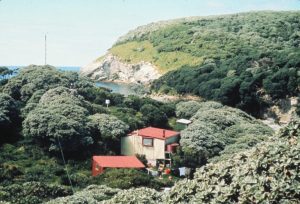What follows is an abstract of a most complete past history of Castaway Depots (Huts) in the remote Sub Antarctic Islands of New Zealand. Most of the Huts and Depots in these islands are listed on the WAP WADA Directory and they just need to be visited by Hams to put such rare ones on the air.
The Snares Islands in particular (The Snares consist of the main North East Island WAP NZL-10 and the smaller Broughton island as well as the Western Chain Islands) , but also Antipodes Islands (The island group consists of one main island, Antipodes Island WAP NZL-11, Bollons Island to the North, and numerous small islets and stacks), and some never activated islands in the Aucklands Group (Auckland Island WAP NZL-Ø4 & NZL-Ø9 is surrounded by smaller Adams Island, Enderby Island WAP NZL-Ø8, Disappointment Island, Ewing Island, Rose Island, Dundas Island, and Green Island).
Also known as Castaway Huts, Castaway depots were small shelters strategically placed on isolated islands by governments or maritime organisations and equipped with basic supplies and tools to people who survived shipwrecked and found themselves stranded. These little isolated huts tell legendary stories of bravery, adventure and loss, passed down for generations, but was has become of them? Are there any left?
 Picture aside: Snares Island Castaway Depot & Research Hut first built by the New Zealand government in the 1880s, is now maintained as an historic site by the Department of Conservation. The use of Castaway depots began in the 19th Century and continued into the 20th Century and typically contained items such as food, water, medical supplies, and other essential items that could help stranded seafarers survive until escape or rescue. The idea was started by the New Zealand government in the 19th century when it erected several depots scattered across the Chatham, Kermadec, and the Subantarctic Islands. One particular island, Disappointment Island, had been named as such due to the frequent occurrence of shipwrecks on the island and its extreme lack of resources. The small hut-like structures could withstand high winds and hurricanes as best as possible for as long as possible in the hopes of saving the lives of potentially shipwrecked men.
Picture aside: Snares Island Castaway Depot & Research Hut first built by the New Zealand government in the 1880s, is now maintained as an historic site by the Department of Conservation. The use of Castaway depots began in the 19th Century and continued into the 20th Century and typically contained items such as food, water, medical supplies, and other essential items that could help stranded seafarers survive until escape or rescue. The idea was started by the New Zealand government in the 19th century when it erected several depots scattered across the Chatham, Kermadec, and the Subantarctic Islands. One particular island, Disappointment Island, had been named as such due to the frequent occurrence of shipwrecks on the island and its extreme lack of resources. The small hut-like structures could withstand high winds and hurricanes as best as possible for as long as possible in the hopes of saving the lives of potentially shipwrecked men.
There are at least five notable shipwrecks that occurred on the Auckland Islands in which all or most of the crew was saved by the provisions left in castaway depots. The last shipwrecked crew to survive as castaways was the crew of the French barque President Felix Faure that was wrecked off the North Cape of Antipodes Island in 1908. The entire crew made it to shore close to a castaway depot. When all the supplies had been depleted, the crew hunted albatross, penguins, and a single calf; the sole remnant of the cattle that had been set ashore with other supplies by the Hinemoa, a New Zealand government service steamer that serviced and patrolled New Zealand territorial waters. The crew of was rescued by the HMS Pegasus and eventually made a successful return journey to France via Sydney.
Thanks and credit: A Shipwrecked Sailor’s Guide to Castaway Depots (messynessychic.com)
